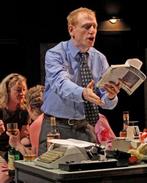SITE GUIDE
SEARCH
REVIEWS
REVIEW ARCHIVES
ADVERTISING AT CURTAINUP
FEATURES
NEWS
Etcetera and
Short Term Listings
LISTINGS
Broadway
Off-Broadway
NYC Restaurants
BOOKS and CDs
OTHER PLACES
Berkshires
London
California
New Jersey
DC
Connecticut
Philadelphia
Elsewhere
QUOTES
TKTS
PLAYWRIGHTS' ALBUMS
LETTERS TO EDITOR
FILM
LINKS
MISCELLANEOUS
Free Updates
Masthead
Writing for Us
A CurtainUp  London Review
London Review
 London Review
London ReviewGatz
|
Her voice is full of money.
— Gatsby
|

Scott Shepherd (Photo: Paula Court) |
The production of the novel about the not so beautiful side of the beautiful people is set in an ugly and scruffy office in the 1980s, initially with the constant drone of big city traffic and horns. Office worker Scott Shepherd starts to read the novel with the usual arrivals and movement of the other office workers behind him which I found quite distracting. However quite soon, these office workers start to play a role from the book and things came alive for me. At first it is the professional sportswoman, golfer Jordan Baker (Susie Sokol) who catches our narrator’s eye with her practise golf swings and for whom he later confesses he has “a tender curiosity” before he is disillusioned and comes to the conclusion that she is incurably dishonest.
We meet rich man and neighbour Tom Buchanan (Gary Wilmes) and his wife, the ethereal and very pretty Daisy (Lucy Taylor) and soon go to New York on a jolly with Tom. This time the jazz age is in full swing and Tom is with one of his mistresses, Myrtle (Laurena Allan) who is married to Tom’s social inferior, George Wilson (Aaron Landsman). Scott Shepherd is Nick, the book’s narrator and he moves to a house across the bay from that of the mysterious Gatsby, about whom a whole set of rumours gathers, along with the guests at his fabulous week long parties. Did he once commit a murder? Is it true that he is a German spy? We wait for the entrance of the eponymous socialite with one of the greatest build ups in literature. And then Gatsby (Jim Fletcher) extends the mystery by telling Nick that he has faced a great sadness and explaining that someone else will explain it all.
The early scenes have quite a lot of humour, not in the book but to do with the improvised nature of the production as a rag doll (why not a toy dog?) perversely stands in for the puppy Myrtle bought in New York. We also laugh at Nick’s antics with his antique pc which reliably and frequently freezes, and again nothing to do with the book.
Every word in the book is there, including the he saids and she saids, unnecessary in later scenes when the actor is voicing the words. However it was when Nick put down the book and no longer pretended that he was reading that I felt Scott Fitzgerald’s wonderful prose jump off the pages of the book. This made me want to return to the text. Although Nick openly talks about Tom’s transition from libertine to prig, it is the bandage on Myrtle’s broken nose, broken when Tom hit her, that even when she is playing roles other than Myrtle is an ever present reminder of his mistreatment of a woman.
It is of course a virtuoso performance from this small company. Scott Shepherd knows every word of the novel, a great feat. The question for me is whether this dramatisation is the best way to experience The Great Gatsby. As I love reading and picturing the characters in my mind’s eye I think I would be more at home with a copy of the novel. In England from the 1990s we have had Shared Experience’s physical experiential staging of the great novels and those marathon Dickensian productions of Nicholas Nickleby as well as the BBC television serial dramatisation of the classics. The strength of the ERS is undoubtedly the intact nature of the prose but a drawback is the actors cast as 1980s office workers rather than as the personification of their 1920s characters and a full suspension of disbelief.
|
Subscribe to our FREE email updates with a note from editor Elyse Sommer about additions to the website -- with main page hot links to the latest features posted at our numerous locations. To subscribe,
E-mail: esommer@curtainup.comesommer@curtainup.com
put SUBSCRIBE CURTAINUP EMAIL UPDATE in the subject line and your full name and email address in the body of the message -- if you can spare a minute, tell us how you came to CurtainUp and from what part of the country. |
| Gatz
Written by F Scott Fitzgerald Directed by John Collins With: Scott Shepherd, Gary Wilmes, Susie Sokol, Jim Fletcher, Lucy Tasylor, Ross Fletcher, Larena Allan, Annie McNamara, Kate Scelsa, Aaron Landsman, Ben Williams, Mike Iveson, Vin Knight Set Design: Louisa Thomson Costumes: Colleen Werthmann Lighting: Mark Barton Sound: Ben Williams Running time: Eight hours with three intervals including a 90 minute meal break Box Office: 0844 482 5141 Booking to 15th July 2012 Reviewed by Lizzie Loveridge based on 15th June 2012 performance at the Noel Coward Theatre, St Martin’s Lane London WC2N 4AU (Tube: Leicester Square) |
|
REVIEW FEEDBACK Highlight one of the responses below and click "copy" or"CTRL+C"
Paste the highlighted text into the subject line (CTRL+ V): Feel free to add detailed comments in the body of the email . . . also the names and emails of any friends to whom you'd like us to forward a copy of this review. |




